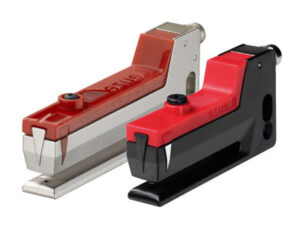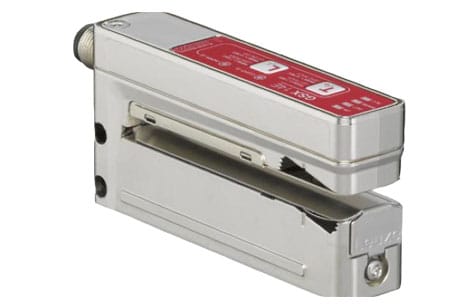
Understanding Label Gap Sensors:How They Work & Packaging Applications
Label gap sensors play a crucial role in many industries, helping to ensure that product labels are applied accurately and efficiently. These essential devices make it easier to package and label items, which is especially important in today’s fast-paced production environments.
In this blog post, we will explore the world of label gap sensors in a simple and easy-to-understand way, making it accessible to students, engineers, and anyone interested in learning more about this technology.
We will discuss how these sensors work, their importance in the packaging industry, and what to consider when selecting the right sensor for your needs. By the end of this post, you’ll have a clear understanding of label gap sensors and their impact on packaging processes.
So, let’s get started and learn more about these fascinating devices!
What is a Label Gap Sensor?
A label gap sensor is an electronic device that is commonly used in the labeling and packaging industry to detect gaps between labels. The sensor detects the separation between two labels as they pass through the machine, allowing the labeling equipment to properly space and apply labels to products.
Label gap sensors typically use optical sensors to detect the gaps, which can be either reflective or transmissive. Reflective label gap sensors use a light source to detect the gap between two labels, while transmissive sensors use a light source and a receiver to detect the gap. When the gap is detected, the sensor sends a signal to the labeling equipment, which adjusts the label application accordingly.
Label gap sensors are crucial for ensuring accurate and consistent labeling of products, and preventing labeling errors and waste. They are commonly used in the food and beverage industry, pharmaceutical industry, and many other industries that require accurate labeling of products.

The Importance of Label Gap Sensors Across Industries
Label gap sensors are essential in a wide range of industries, contributing to efficient and high-quality packaging processes. The accurate application of labels is vital for meeting industry standards, ensuring product traceability, and providing essential information to consumers.
Some key industries where label gap sensors play a significant role include:
Food and Beverage: Ensuring proper labeling of ingredients, nutritional information, and expiration dates.
Pharmaceuticals: Maintaining accurate labeling for dosage information, active ingredients, and safety warnings.
Consumer Goods: Facilitating brand recognition and providing essential product information through clear and well-positioned labels.
Electronics: Labeling components and devices for traceability and regulatory compliance.
By optimizing the labeling process, label gap sensors contribute to increased efficiency, reduced waste, and improved quality control across various industries.
How Label Gap Sensors Work
Label gap sensors function by detecting the difference between the label material and the gap or space between labels on a continuous roll. When the sensor detects a gap, it sends a signal to the labeling machine, which then knows the precise position to apply the label to the product. This ensures accurate label placement, contributing to a streamlined packaging process and improved quality control.
Types of Label Gap Sensors
There are 3 main types of label gap sensors, each with distinct working principles and suited to different applications:
- Capacitive Label Gap Sensors
- Ultrasonic Label Gap Sensors
- Optical Label Gap Sensors
Capacitive Label Gap Sensors: Capacitive label gap sensors work by measuring changes in capacitance between the sensor’s face and the label material. The capacitance varies depending on the distance and the dielectric properties of the material being sensed.
As the label material and the gap have different dielectric properties, the sensor can accurately identify the gap between labels. Capacitive sensors are suitable for detecting a wide range of materials, including paper, plastic, and metallic labels.
Ultrasonic Label Gap Sensors: Ultrasonic label gap sensors use sound waves to detect the presence or absence of a label. The sensor emits high-frequency sound waves, which then bounce off the surface of the label material and return to the sensor.
The time it takes for the sound wave to return allows the sensor to calculate the distance to the material. Since the gap between labels has a different acoustic profile, the sensor can accurately identify the gap. Ultrasonic sensors work well with transparent or irregularly shaped labels, as well as labels with varying colors and opacity levels.
Optical Label Gap Sensors: Optical label gap sensors utilize light to detect the difference between the label material and the gap. These sensors typically consist of a light source (LED or laser) and a light receiver (photodetector). The light emitted by the source reflects off the label material and is detected by the receiver.
When the sensor detects a change in the amount of reflected light, it identifies the gap between labels. Optical sensors are ideal for applications where the label material has a consistent, contrasting background, such as printed labels on a transparent or white backing.
The Role of Label Gap Sensors in the Packaging Industry
Label Application Process
The label application process involves several steps that ensure the accurate and consistent placement of labels on products or packages. The process typically includes the following steps:
Label design: The first step in the label application process is the design of the label itself. The label design should take into account the product or package dimensions, as well as any regulatory requirements or branding considerations.
Label printing: Once the label design is finalized, the labels can be printed using a variety of printing methods, such as digital printing, flexographic printing, or screen printing.

Label inspection: Before applying the labels to products or packages, it’s important to inspect them for any defects or quality issues. This can be done using visual inspection or specialized label inspection equipment.
Label application: The labels are then applied to products or packages using label applicators or labeling machines. These machines use various methods to ensure accurate label placement, such as sensors, rollers, or brushes.
Label verification: After the labels are applied, they should be verified for accuracy and consistency. This can be done manually or by using label verification systems that check for correct placement, alignment, and readability.
Label tracking: Finally, the labeled products or packages should be tracked to ensure that the correct labels are applied to the right products and that the labeling process is consistent and efficient.
By following these steps, companies can ensure that their products are properly labeled and comply with regulatory requirements, while also maintaining brand consistency and quality control.
Benefits of Using Label Gap Sensors in Packaging
Improved Accuracy and Consistency: Label gap sensors ensure precise label placement, leading to consistent product labeling and a more professional appearance.
Reduced Waste and Costs: By minimizing labeling errors, label gap sensors help reduce waste from mislabeled products and the costs associated with re-labeling or discarding them.
Enhanced Quality Control: Label gap sensors contribute to better quality control by ensuring that each product is correctly labeled, which is essential for compliance with industry standards and regulations.
Common Packaging Applications
Food and Beverage: In the food and beverage industry, label gap sensors are vital for accurately applying labels that display ingredients, nutritional information, and expiration dates, helping to ensure consumer safety and regulatory compliance.
Pharmaceuticals: Pharmaceutical packaging requires precise labeling of dosage information, active ingredients, and safety warnings.
Label gap sensors help ensure that these essential details are consistently and accurately applied, maintaining the highest standards of quality and safety.
Consumer Goods: Label gap sensors play a key role in the consumer goods industry, where accurate labeling is necessary for brand recognition and for providing essential product information.
By ensuring consistent and precise label placement, these sensors contribute to a polished and professional appearance that enhances the overall customer experience.
Factors to Consider When Choosing a Label Gap Sensor
Selecting the right label gap sensor is a critical decision that can significantly impact the efficiency, accuracy, and overall success of your packaging process. With a variety of sensor types and technologies available, it can be challenging to determine which one is best suited to your specific needs.
By understanding these factors and carefully evaluating your options, you can make an informed decision that will enhance your labeling process and ensure the highest standards of quality and performance.
Sensor Type and Compatibility: When selecting a label gap sensor, it’s essential to consider the type of sensor that will best suit your specific application. Capacitive, ultrasonic, and optical sensors each have their advantages and limitations depending on the label material, shape, and size.
Ensure that the sensor you choose is compatible with the materials and production environment in which it will be used.
Application Requirements: Consider the unique requirements of your application, such as the speed of your production line, the range of label materials and sizes you will be working with, and any specific regulatory or industry standards that must be met.
Select a label gap sensor that can effectively handle these requirements while maintaining accuracy and efficiency.
Environmental Conditions: The operating environment can significantly impact the performance of a label gap sensor. Factors such as temperature, humidity, dust, and vibration should be taken into account when choosing a sensor.
Select a sensor with appropriate environmental ratings and protection to ensure reliable performance under your specific operating conditions.
Budget and Cost-effectiveness: While it’s essential to choose a high-quality and reliable label gap sensor, it’s also important to consider the cost of the sensor and its overall value for your operation.
Compare the features, performance, and durability of different sensors within your budget to determine which option will provide the best return on investment and long-term benefits for your packaging process.
Conclusion
In conclusion, label gap sensors are a critical component of the packaging industry, playing a vital role in ensuring accurate label placement and efficient packaging processes. With their ability to detect gaps between labels, they help prevent labeling errors and ensure compliance with industry standards and regulations.
In this blog post, we have explored the working principles of label gap sensors, including their types, advantages, and crucial factors to consider when selecting the right sensor for your specific application. By carefully evaluating your unique requirements, operating environment, and budget, you can find the ideal label gap sensor to enhance your labeling process’s overall efficiency and quality.
Investing time and effort into understanding and selecting the right sensor can have a significant impact on the success and efficiency of your packaging process. We encourage readers to continue exploring this essential technology and seek advice from experts or suppliers to ensure informed decision-making.
We hope this blog post has provided valuable insights and guidance as you navigate the process of selecting the best label gap sensor for your needs.
